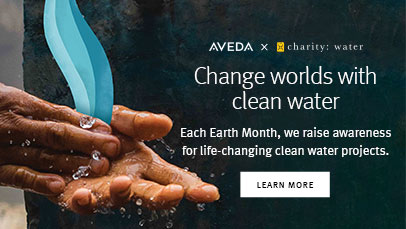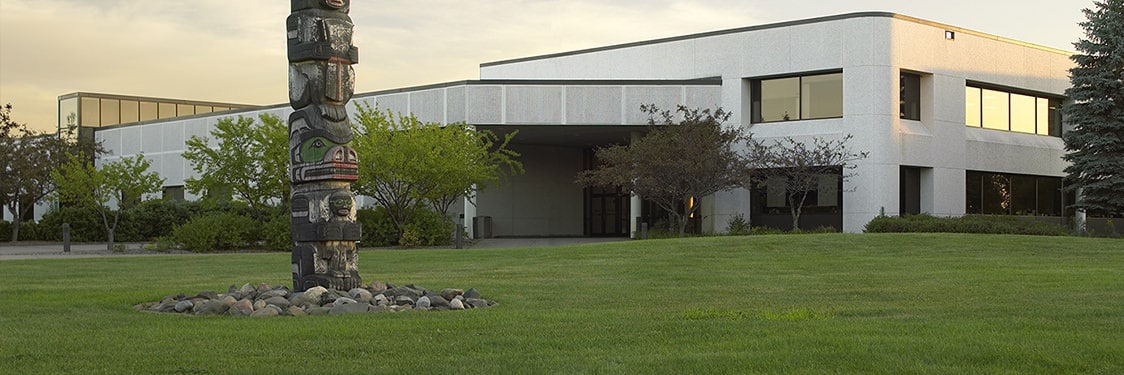Aveda, Employees, and the Blaine Campus
The People of Aveda and the Aveda Experience
Our geographic distribution includes North America, Europe, Middle East, Asia and Australia. Professional salons and spas remain our core distribution channel with supplementary channels that include Aveda-owned and independent retail Experience Centers, salons and spas, Institutes that train industry professionals, select department stores and specialty retailers, and online sales through aveda.com.
The Aveda Distribution Network, July 2016
Department and Specialty Stores | Retail, Format, and Travel Stores | Salons and Spas | Online and Other | |
U.S. | 93 | 127 | 5,623 | 1 |
Canada | 0 | 11 | 760 | 1 |
Other Americas | 0 | 1 | 0 | 25 |
Europe, Middle East, Africa | 78 | 16 | 1,817 | 19 |
Asia, Pacific | 66 | 69 | 930 | 3 |
We consider the employees of Aveda to be our key stakeholders. They are the people that hold us accountable to our Mission, who create, make, and deliver the high-performance products that set us apart in the beauty industry, and who contribute their time and energy to the communities in which we operate and the places that they live. As of June 30, 2016, Aveda had approximately 3,100 employees around the globe (2,500 in the U.S. and 600 at International locations).
At our Blaine campus, where most of our non-sales employees are located, we are a predominately female-staffed organization (61%) and about two-thirds of our senior executives, managers and professionals are women. About 40% of our manufacturing and distribution employees are female. Our minority population in Blaine–16% of the staff–reflects the general demographics of the Twin Cities, and has grown since the last report.
Our in-store retail employees and our employees who provide support and education to the Aveda network make up the majority of our U.S. employee population. About 80% of our total U.S. workforce is female and about 30% of the total are temporary or on-call employees. At Blaine, approximately 17% were temporary or on-call employees during fiscal year 2016.
Aveda’s Human Resources (HR) function was part of the Estee Lauder Companies’ HR Transformation initiative. This initiative began in 2015 and continues to evolve. Transactional and administrative tasks are handled by an Employee Services team in New York. This allows our Blaine-based HR team to focus on more strategic work allowing them to better partner with the business. A new HR system allows employees and managers to easily access information and initiate their own transactions.
We continue to encourage employees to incorporate environmental and social responsibility into both their work and their lives. HR has a significant role in maintaining this core cultural aspect through talent acquisition, talent development and positive employee relations. Our living the mission goal is still the first business goal in all Aveda employees’ Performance Development Plans. In fiscal year 2016, we increased (doubled) the weighting of this goal to be worth 10% of the total for business goals in all employee reviews. Because they care deeply about the Aveda Mission, we believe they work harder to find more eco-intelligent ways to do business.
Aveda Blaine Campus Employees (June 2016)
JOB CATEGORY | TOTAL | % | % | % | % |
First/Mid-Level Officials and Managers | 233 | 63% | 37% | 88% | 12% |
Professionals | 101 | 70% | 30% | 93% | 7% |
Technicians | 27 | 70% | 30% | 89% | 11% |
Sales Staff | 4 | 100% | 0% | 100% | 0% |
Administrative Support Workers | 100 | 96% | 4% | 94% | 6% |
Craft Workers | 11 | 0% | 100% | 100% | 0% |
Operatives | 154 | 24% | 70% | 65% | 35% |
Laborers and Helpers | 74 | 74% | 26% | 59% | 41% |
Service Workers | 18 | 67% | 33% | 61% | 39% |
Total Blaine Employees | 722 | 61% | 39% | 84% | 16% |
WE ARE OBTAINING GLOBAL NUMBERS TOO |
|
|
|
|
|
Aveda Mission Leader
Aveda Mission Leader™ is our online sustainability engagement platform designed to deepen employee understanding about the environment and their commitment to the Aveda Mission through gamification and social normalization. Established in fiscal year 2014, it has grown to include over 750 Aveda employees. The platform delivers educational learning at an individualized pace and level for each employee and serves as a means of engaging the Aveda community in actions within their professional and personal lives.
Participants pick from diverse “Projects” ranging from zero waste to saving water, health and wellness, green salon certification, green living, mindful eating, and many more. Within each project, there are specific learnings that the participant pursues that explain the project’s purpose, specific actions to complete the project, and why their actions matter. Participants update their progress through to completion, earning points for each action completed and achievement badges as they advance through the levels; with incentives offered on a regular basis to promote participation. From fiscal years 2014 to 2016, Aveda Mission Leader also served as an organizing platform for community volunteer activities for both Aveda initiatives (Activism for the Earth) and employees’ own volunteer opportunities (more information is available in The Ways We Give Back to Society section). From its inception to the end of fiscal year 2016, 87,114 actions had been completed. Beginning in fiscal year 2017, coordination and tracking of Aveda volunteer activities are shifting to the ELC Good Works platform.
Workplace Safety and Health Trends
Aveda continues a nearly two-decade trend of declining rates of recordable safety and health incidents, although rates have fluctuated. The fiscal year 2016 total incident rate (1.44) was 44% below fiscal year 2014 and 38% below fiscal year 2012 (2.31). We attribute the long-term term trend to the Behavior Based Safety program we instituted in the mid-2000s, the attention of Aveda’s leadership to safety, Gemba safety walks, and our employee safety teams, who raise accountability and awareness.
We are very proud of our workplace and its safety and health management systems. The Minnesota STAR (MNSTAR) Program is a Minnesota Occupational Safety and Health Administration (MNOSHA) program that recognizes companies where managers and employees work together to develop safety and health management systems that go beyond basic compliance with all applicable OSHA standards and result in immediate and long-term prevention of job-related injuries and illnesses. Key elements of this comprehensive program include: management leadership and employee involvement; an allocation of resources to address safety issues; systems that identify and control workplace hazards; and a plan for employee safety training and education. Aveda Corporation, Manufacturing Site and our Midwest Distribution Center are two of only 37 business in Minnesota in 2017 and have been part of the program since 2008.
Pedestrian Safety Paths
Factories are typically very busy places. Aveda’s Blaine manufacturing facility shares a building with our corporate offices, our dining facility, Organica, a research salon, an Aveda Experience Center and Research and Development; while nearby is our Midwest Distribution Center. The manufacturing area houses among other things the production facility, incoming and outgoing shipping, raw material storage, interim product storage, and our facilities group, all of which generate pedestrian traffic, along with corporate office staff who interact with work groups within the facility and staff that walk through the area going to and from other parts of the campus. Similar to other facilities, the manufacturing area uses fork trucks (electrified to reduce emissions and noise) and material handling equipment to move materials, equipment and products. As Kim Yoakum, the Director of Environmental Health and Safety at the Aveda Blaine Campus explains:
“With Aveda's focus on employee safety, we installed a pedestrian pathway in our manufacturing facility during FY 2016. This guarded pathway was implemented to ensure everyone walking within the manufacturing area was safe. The focus was to limit any person and powered material handling equipment (PMHE) interaction. To do that, we moved the main pedestrian route for non-manufacturing staff out of the areas where the fork trucks generally operate. We also installed employee controlled crossing arms at two key areas to allow employees to safely pass without worrying about PHME moving in the pathway. After an initial testing period, all employees began using the pedestrian pathway and we have received positive feedback on this safety initiative.
“We also took the opportunity to address an issue outside the buildings to improve the safety culture for everyone who steps foot onto the Aveda campus. We added additional striping to denote walk zones on the roadway and parking areas for greater pedestrian visibility and safety.”
Blaine Campus Stewardship
Aveda’s Blaine, Minnesota campus sits on 58+ acres that houses our corporate offices, a retail Experience Center, a test salon, our manufacturing facility and our Midwest Distribution Center. What began as a typical suburban landscape has evolved into a practical demonstration of how we implement the Aveda Mission. Native plants, bird nest boxes and roosting structures, and avoiding toxic materials are standard practices that create welcoming environments for birds, bees (see the 2013-2014 ECC Report for more on Aveda’s pollinator projects), and a variety of other wildlife. Nathan DeJarnett, Aveda’s Facilities Sustainability Specialist, explains what we have done in recent years:
“I’ve spent almost 13 years in Aveda’s facilities department working on our grounds, outdoor facilities, and ecological restoration projects. When I started, the Blaine campus consisted primarily of a lot of lawns along with some open spaces and water features. In 2008, Aveda set aside two-thirds of the campus as a National Wildlife Federation-certified wildlife habitat. We nurture and protect the sensitive ecosystem at our site against threats such as invasive species of insects, plants and wildlife. With each new landscape project we take on, we strive to create a natural habitat for local birds and other animals by including restorative elements.”
“In FY 2013, we created an organic garden, providing 20 plots for employees who want to plant vegetables, fruits and flowers. The garden also assists in providing foraging areas for Aveda’s bee colonies. Pollination is crucial to our business as a plant-based products company and is critical to enhancing global biodiversity. The Aveda Honey Bee Project was started in FY 2014 as part of a larger Aveda effort to raise awareness about the need to protect pollinators and their habitats. Between FY 2007 and FY 2015, five to seven acres were restored from parking areas or lawns back to prairie land.”
“Aveda cares for many social and environmental causes and one of the causes very close to our hearts are birds. Through our strong partnership with Audubon Minnesota, we help protect bird habitat and safeguard water for birds. In 2011 Dominique Conseil began noticing birds flying into window panes on our campus in Blaine. Bird strikes like these occur when birds see reflections of habitat, water, or mates in windows or when they simply don’t notice the glass. We began regularly walking the perimeter of our buildings trying to understand the problem. For every dead bird we found, we knew that there may be more that flew off but later perished. We contacted Audubon Minnesota because of their successful work around raising awareness about bird conservation as part of their Bird-Friendly Communities campaign. They helped us work through our options for addressing this issue. Along with Cindy Angerhofer, I’ve been tracking the amount of bird strikes for about 4 years, noting periods of increased activity, location of strikes, bird types, etc. We log the data and share it with Audubon for research purposes.”
As Aveda’s senior plant scientist, Cindy got involved in the bird issue in both her professional capacity and as a long-time bird enthusiast:
“There are recommendations for dealing with bird strikes, and the solution that most experts agree on is to cover windows with some sort of film that birds can see, never leaving more than 2 x 4 inches of exposed glass in one place. This means a lot of area needs to be covered, which may not only break up the view, but and can get expensive.”
“We tested several types of decals considering cost, material attributes and functionality. There were decals made of vinyl (PVC) that didn’t have to cover the entire window and there were PVC-free solutions that came with a higher price tag. In the end, we decided to pay more for a mission-aligned PVC-free solution using a patterned window treatment that allows good visibility, is attractive to people while visible enough to effectively warn birds away. Since installation, we haven’t seen a single bird on the ground below our windows. Because of the higher cost of PVC-free material, we are installing the new window treatment in phases, prioritizing areas with the highest bird activity, with a goal of completing all areas of concern and replacing worn decals as needed.”
“Bird strikes are a real problem, and we have an opportunity through our networks, partnerships, stores and salons to spread knowledge about what can be done to save birds from being lost. We’d like to use our experience as an educational tool for employees and guests to learn about bird strike prevention, and we’re currently working with Audubon to develop informational material for our stores. According to Audubon, most bird kills happen in residential areas, especially around low-rise buildings, and where light emanates upward from windows so the potential benefit of raising awareness is enormous.”
Learn more about what you can do in these articles from the Audubon Society, American Bird Conservancy and Cornell Lab of Ornithology.
mn.audubon.org/conservation/bird-friendly-communities/landing/project-birdsafe
mn.audubon.org/conservation/birdsafe-homes
allaboutbirds.org/glass-action-advances-in-the-science-of-making-windows-safer-for-birds
allaboutbirds.org/Page.aspx?pid=1184#why
allaboutbirds.org/7-things-you-can-do-to-help-songbirds-if-youve-just-watched-the-messenger
abcbirds.org/get-involved/bird-smart-glass
collisions.abcbirds.org/design.html
Rain Gardens and Parking Lots
Employees and visitors have extremely limited opportunities to use mass transit to get to our Blaine-based campus however we highly encourage carpooling and bicycling and provide dedicated spots for carpools and showering facilities and lockers for bike commuters. During fiscal year 2015-2016, Aveda embarked on a number of improvements to our parking lot to gain environmental improvements and safety upgrades. In the first phase of the parking lot renovation, we added rain gardens—planted areas that collect storm water from pavement and walkways—to absorb and clean the runoff from impervious surfaces. The second phase involved installation of pervious pavers in a portion of the lot to allow water to flow through to the ground rather than to the sewer, reducing surface runoff and trapping pollutants from cars before they reach local streams or groundwater. Most recently, we added electric vehicles (EV) charging ports for those employees with EVs.
Minnesota Sustainable Growth Coalition
Aveda has long believed in the power of collaboration to overcome challenges and achieve meaningful common goals within sustainability. We found one such opportunity through the Sustainable Growth Coalition, a group of more than 30 businesses and organizations in the Greater Minneapolis area, aimed at establishing Sustainability leadership in the region. Aveda’s noteworthy contribution to the coalition is to ensure that the broader group strives to do more than take on simple efforts, but instead pushes boundaries, thinks big, and continues to strive for sustainability leadership.
The focus of the group is an old idea transformed into the next frontier in corporate sustainability, a circular economy. Several efforts are underway within the Sustainable Growth Coalition to establish a vision for a circular economy, determine possible steps to achieving it, and develop projects and initiatives that will move Minnesota toward a circular economy. The coalition is initially exploring joint group initiatives that would demonstrate early steps toward circular systems addressing water, energy, and organic waste.
The Coalition builds on a long interest in sustainability among its members, many of whom are members of other industry groups with a similar focus. The concept of circular systems is a significant topic for number of these groups, especially with the initiatives led by the Ellen Macarthur Foundation on achieving a circular economy that preserves natural capital, maintains resource productivity, and designs out negative impacts on ecosystems and health.
Business for Innovative Climate and Energy Policy (BICEP)
Aveda joined BICEP, a coalition of businesses advocating for policies to address climate change convened by our long-time partner CERES, in 2013. As part of this commitment, in July 2015, Aveda was one of 365 companies to sign a letter supporting state implementation of the Environmental Protection Agency’s carbon pollution standards that went to more than two dozen governors across the United States. That autumn, BICEP actively worked to demonstrate business support for a strong international action which helped set the stage for the landmark Paris Agreement signed by more than 190 countries in December 2015. Aveda was among hundreds of companies to sign the Business Backs Low-Carbon USA letter to President-elect Trump, President Obama, Members of the U.S .Congress and Global Leaders in November 2016 reaffirming their support for the historic Paris Climate Agreement and the need to accelerate the transition to a low-carbon economy at home and around the world.
Awards
| Aveda product recognitions and awards | |||
| In consumer publications | In trade publications | ||
Domestic | 2015 | 11 | 7 | |
2016 | 16 | 5 | ||
International | 2015 | 24 | 6 | |
2016 | 34 | 0 | ||
| 85 | 18 | ||
Click to return to Think Report Home




